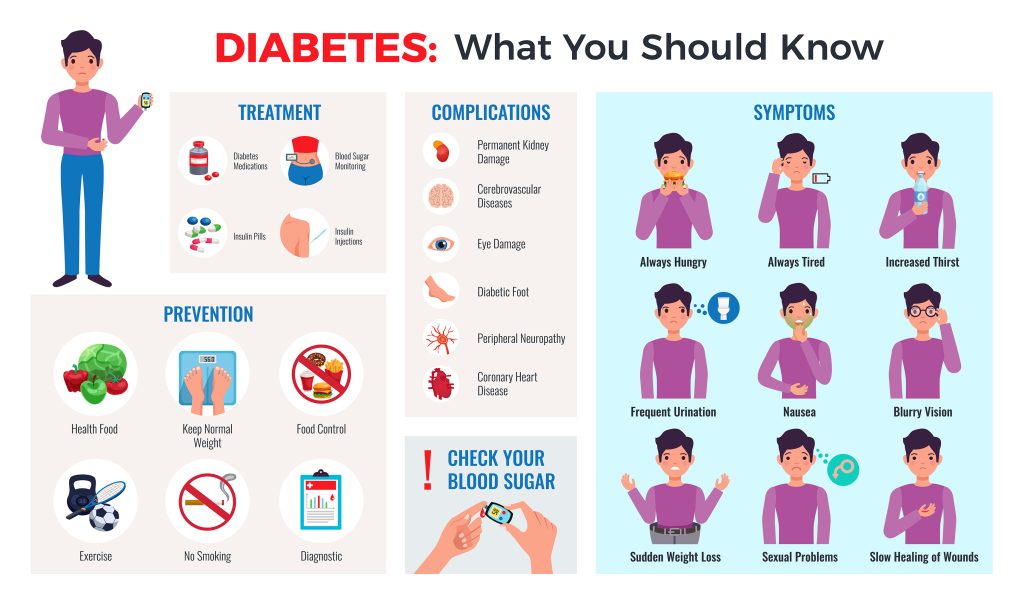According to a study, an estimated 537 million adults (20-79 years) were living with diabetes, and this number is projected to rise to 643 million by 2030. Diabetes is a chronic condition that occurs when the body cannot produce enough insulin or use it effectively. Insulin is a hormone that regulates blood sugar levels. High blood sugar levels can damage various organs and tissues, leading to serious complications such as heart disease, kidney failure, blindness, and amputation.
This growing trend underscores the urgency for early detection and management of the condition. That’s why we have designed our diabetes assessment tool to help you assess the risk of developing diabetes. By answering a series of questions, you can better understand the risk factors for diabetes.
Factors Affecting Diabetes Risk
Diabetes is a complex, multifactorial disease that can impact anyone, including teenagers who face unique challenges. Puberty brings hormonal changes affecting insulin sensitivity and blood sugar levels, complicating diabetes management. Unhealthy eating habits, influenced by peer pressure and media norms, can disrupt blood sugar levels and lead to complications. Stress from academic, family, or relationship issues can trigger emotional eating and impact mental health, affecting diabetes management and overall well-being.
Teenagers with diabetes may experience significant effects on physical, mental, and emotional health, as well as social and academic performance. The condition increases the risk of long-term complications like cardiovascular disease, nerve damage, and kidney disease. Early prevention, detection, and treatment are crucial for managing diabetes effectively. Check our Food Allergy Assessment, a helpful resource for parents navigating the challenges of food allergies in their preteen children.
Early Detection and Management of Diabetes Risk Factors
Early detection of diabetes risk factors can prevent complications and promote healthier lifestyles. Common risk factors for teenage diabetes include family history, obesity, physical inactivity, unhealthy diet, and high blood pressure or cholesterol.
Identifying risk factors early allows for timely intervention, lifestyle changes, and medical management. Interventions include education on healthy eating and exercise, monitoring blood sugar levels, managing stress, and seeking regular medical support.
Type 1, Type 2, and Gestational Diabetes
This table can help you understand the key characteristics and differences between the main types of diabetes.
| Feature | Type 1 Diabetes | Type 2 Diabetes | Gestational Diabetes |
|---|---|---|---|
| Definition | Autoimmune reaction where the body attacks and destroys insulin-producing beta cells in the pancreas. | Body becomes resistant to insulin or doesn’t produce enough. | High blood sugar levels during pregnancy in women who haven’t had diabetes before. |
| Risk Factors | Genetic predisposition, environmental factors, presence of certain autoantibodies. | Overweight, age (older), family history, physical inactivity, ethnicity. | Family history of diabetes, overweight before pregnancy, age (older), ethnicity. |
| Onset | Typically childhood, adolescence, but can occur at any age. | Often in adults, but increasing in children due to obesity. | During pregnancy. |
| Symptoms | Increased thirst, frequent urination, hunger, weight loss, fatigue, blurred vision. | Often similar to Type 1 but can be less pronounced; sometimes no symptoms. | Often no symptoms; detected through screening during pregnancy. |
| Management | Lifelong insulin therapy, monitoring blood sugar, diet and exercise. | Lifestyle changes, oral medications, insulin (if necessary). | Diet modifications, exercise, blood sugar monitoring, sometimes insulin or oral medications. |
| Complications | Heart disease, kidney damage, eye damage, nerve damage, foot problems. | Similar to Type 1, increased risk of heart disease, kidney damage, etc. | Increased risk of cesarean delivery, high blood pressure during pregnancy, type 2 diabetes later in life. |
| Prevalence | Less common than Type 2. | Most common type of diabetes. | Affects 2-10% of pregnancies in the U.S. |
Preventing Diabetes: Taking Charge of Your Health
Fortunately, there’s a lot you can do to prevent type 2 diabetes, the most common form. Here’s what science suggests based on information from the National Institutes of Health:
Lifestyle Changes:
- Weight Management: Aim for a healthy weight. If you’re overweight or obese, losing even 5-10% of your body weight can significantly reduce your risk.
- Eat a Balanced Diet: Focus on whole grains, fruits, vegetables, and lean protein sources. Limit processed foods, sugary drinks, and unhealthy fats.
- Move Your Body: Aim for at least 30 minutes of moderate-intensity exercise most days of the week. Physical activity helps your body use insulin more effectively.
Additional Tips:
- Quit Smoking: Smoking significantly increases your risk of type 2 diabetes.
- Get Regular Checkups: Talk to your doctor about your risk factors and get tested for prediabetes if needed.
Overcoming Diabetes: Managing for a Healthy Life
If you’ve already been diagnosed with diabetes, don’t despair. With proper management, you can live a long and healthy life. Here are some key strategies:
- Follow Your Doctor’s Plan: This may include medication, dietary changes, and exercise recommendations.
- Monitor Blood Sugar Levels: Regularly checking your blood sugar helps you and your doctor adjust your treatment plan as needed.
- Maintain a Healthy Diet: Similar to prevention, focus on whole foods and limit processed options.
- Stay Active: Exercise is crucial for managing blood sugar levels.
Remember, consult your doctor for personalized advice on preventing or managing diabetes.
Additional Resources
Related Assessments

